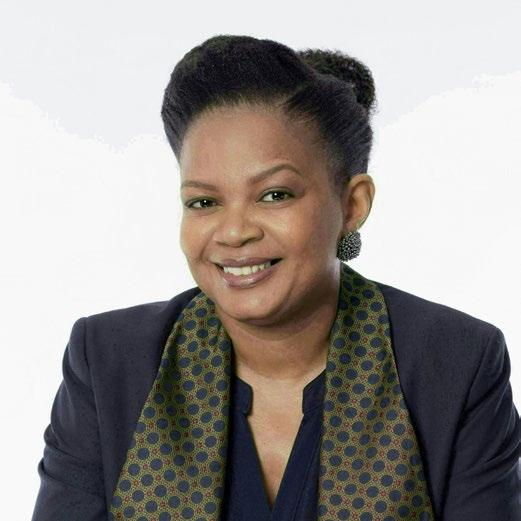
8 minute read
Leveraging The Full Spectrum Of Human Potential
The Representation Of Women In STEM
By Dr Mmaki Jantjies
As we celebrate Freedom month, it is important to acknowledge the progress made in ensuring the economic participation of women in South Africa, particularly in the STEM sector (science, technology, engineering and mathematics). The country’s history of working towards a free and just society has been underpinned by the important role that women have played in ensuring equality for all. In response, significant milestones have been achieved with policies enabling greater access to opportunities for women.
The role of diversity in the STEM sector is vital to ensure national advancement. By leveraging the full spectrum of human potential, nations like South Africa will not only unlock innovation but also build a more equitable and prosperous future for all.
Considering the significant strides made in advancing female participation in STEM sectors, South Africa still experiences the underrepresentation of women in key areas today, particularly in STEM leadership positions. What then has led to this “leaky pipeline”, and what initiatives are important in addressing these issues?
Female Representation In STEM
The 2023 Report of the Engineering Council of South Africa underlined that only 14% of registered engineers were women. A 2024 skills survey conducted by the Institute of Information Technology Professionals South Africa (IITPSA) further explored the representation of women in the ICT sector. The survey found that although 39.5% of employees were female, only 5% had leadership positions in ICT companies.
I recently had the opportunity of joining the launch of the South African chapter of the OWSD (Organization for Women in Science for the Developing World), an organisation describing itself as an “international forum to unite eminent women scientists from the developing and developed worlds with the objective of strengthening their role in the development process and promoting their representation in scientific and technological leadership”. The programme provides the mentorship, training and support necessary to ensure a consistent pipeline of women in STEM in the country.
Supported by the National Department of Science and Innovation (DSI), the OWSD event highlights the continuing need for tailored interventions to support the participation of women in key STEM areas. Early interventions in particular were highlighted as being key to facilitating stronger representation of women in the workforce.
The local interventions highlighted below outline the key issues involved in working towards addressing greater gender equity in accessing employment opportunities:
1. Limited Early Exposure and Encouragement
One fundamental obstacle to increasing women’s involvement in STEM is the lack of early exposure and ways of encouraging participation. According to the 2021 data from the Council on Higher Education, female enrolment in STEM programmes at universities stood at around 40%. In line with this low number, the lack of young girls taking up studies in STEM is often attributed to lack of exposure. To address these shortcomings, initiatives aimed at foundational education through interventions like the Department of Basic Education’s TechnoGirl Programme. This initiative has been instrumental in ensuring early exposure, reaching over 30 000 girls from disadvantaged schools and fostering their interest in pursuing STEM careers.
The programme is a partnership between Uweso Consulting in collaboration with UNICEF and the Department of Basic Education. By selecting high school girls from underserved communities, the programme has opened doors to STEM mentorship, skills development, and job shadowing
Another key grassroot intervention has been the Department of Science and Innovation’s National Science Week (NSW). By strategically targeting youth, educators and the general public, particularly those from disadvantaged backgrounds, NSW supports grassroot science literacy. It has programmes which demystify science while showcasing local innovations in those too young to be scientists. This annual event has demonstrated tangible impact by consistently engaging thousands of South Africans annually, enhancing STEM awareness and inspiring youth to pursue STEM careers.
2. Barriers To Access and Participation In Higher Education
Data from the 2020 Human Sciences Research Council (HSRC) study has revealed that students from lower socio-economic backgrounds have dropout rates up to 40% higher than their more affluent peers, primarily due to financial issues. Although both financial and systemic barriers have significantly impeded women’s access to tertiary STEM education, progress is now being made with targeted funding interventions acting to support the advancement of women in STEM.
In responding to these challenges, the National Research Foundation (NRF) has set out to increase female participation in STEM through various initiatives. In 2022, over 60% of National Research Foundation-funded postgraduate students were women within specific STEM categories, demonstrating a clear move towards gender-sensitive funding. Programmes such as the black academic advancement programmes have also been introduced by the NRF to provide grants to black female academics, in order to increase scholarly output while increasing the number of research students supported by grants.
Public private partnerships (PPP), such as the Telkom Centres of Excellence (CoE) based at 14 South African universities, are further examples of partnerships supporting the postgraduate STEM skills development of over 3 500 students. With this programme running over 25 years, Telkom and several ICT organisations have partnered with government in establishing centres at participating universities. These research centres have provided students with access to cuttingedge technology, resources and mentorship, both fostering innovation and contributing to the growth of the ICT sector in South Africa. The Telkom CoE programme supports postgraduate students and research projects, effectively building a pipeline of skilled professionals to meet the evolving demands of the telecommunications and technology industries in South Africa.

3. Lack Of Female Role Models and Mentorship
Globally, the 2023 Global Gender Gap Report states that women comprise 29.2% of the STEM workforce across the 146 nations evaluated, while locally women make up 23% of employed individuals in STEM occupations in South Africa. Organised STEM industry networks are therefore key to improving access to visibility and mentorship opportunities to increase representation. Examples of such in the STEM field are the organisation named Women in Mining South Africa (WiMSA) that offers networking, mentorship and career guidance.
Meanwhile, the South African Women in Engineering (SAWomEng) focuses on professional development and creating a supportive community for female engineers. Public-private initiatives such as the L’Oréal-UNESCO For Women in Science South Africa National Young Talents Programme provide fellowships and visibility to promising young female scientists. The programme has provided funding towards the profiled scientists, while creating a pool of visible female role models that can inspire young girls to pursue STEM careers.
Another initiative which annually recognises female achievement in this sector is Inspiring 50, which publishes the names of the top fifty inspiring women working in STEM. The main objective of this programme is to ensure the visibility and recognition of women within the sectors.
4. Retention and Advancement in STEM Careers
The STEM sector often faces challenges of female employee retention and advancement, particularly with regard to senior leadership roles. This can be impacted by challenges such as family responsibilities, widening pay gaps and lack of clear career progression opportunities. Initiatives have been aimed at removing workplace bias and advancing female progression programmes through targeted initiatives. These programmes have proven to be impactful in ensuring the retention and career progression of women in the sector.
Companies such as Siemens and P&G have implemented “returnship” programs to help women taking career breaks (often for family reasons) to re-enter the STEM workforce. These programmes typically offer training, mentorship and support during the transition back to work. Furthermore, remote and flexible work opportunities have had a significant positive impact on the retention of women in the sector.
In the academic sector, the NRF Thuthuka Programme has been helping women secure academic positions and build research portfolios securing over 70% female grant recipients between 2015-2022.
These programmes provide research grants to emerging researchers, with a focus on young black and female researchers, giving them funds and time towards building their academic career. A significant portion of these grants was awarded to women with the aim of growing the representation and retention of women in STEM in academic institutions.
To truly honour the spirit of Freedom Month and unlock the full potential of South African women in STEM, a holistic, sustained approach is essential to increase the representation of women in these areas. A diverse workforce, including those with strong female representation, will bring a wider array of perspectives, experiences and problem-solving approaches, leading to more creative and robust solutions.
However, guaranteeing greater representation of women necessitates reinforcing early exposure, dismantling systemic barriers to higher education, cultivating robust mentorship networks and fostering the inclusive professional environments enabling women to thrive and lead. It is only through intentional support and collaborative efforts that South Africa can effectively ensure the representation of women in critical fields of science, technology, engineering and mathematics.
Dr Mmaki Jantjies is an innovative leader who is passionate about harnessing the power of technology and R&D to drive change. She is also an Adjunct Associate Professor in Information Systems.











